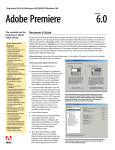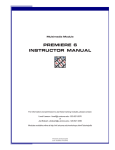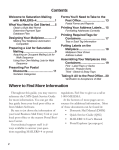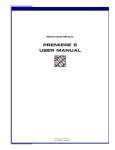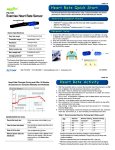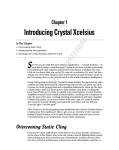Download Wiley Adobe Premiere 6.5 Bible
Transcript
02518305 PP01.F 10/31/02 2:51 PM Page 1 P Getting Started with Premiere A R T I ✦ ✦ ✦ ✦ In This Part Chapter 1 Premiere Quickstart Chapter 2 Premiere Basics Chapter 3 Working with Project Settings Chapter 4 Capturing Video ✦ ✦ ✦ ✦ 02518305 PP01.F 10/31/02 2:51 PM Page 2 03518305 ch01.F 10/31/02 2:53 PM Page 3 1 C H A P T E R Premiere Quickstart ✦ ✦ ✦ ✦ In This Chapter W elcome to the world of Adobe Premiere and digital video. For both experts and beginners alike, Adobe Premiere 6.5 packs the power you need to create sophisticated digital video productions. You can create digital movies, documentaries, sales presentations, and music videos directly from your desktop computer or laptop. Your digital video production can be output to videotape or the Web, or you can integrate it into projects in other programs, such as Adobe After Effects, Adobe Live Motion, Macromedia Director, and Macromedia Flash. This chapter introduces you to the basics of Adobe Premiere: understanding what it is and what you can do with it. This chapter also provides a simple Quickstart project to get you acquainted with the Adobe Premiere production process. You’ll see how easy it is to load digital video clips and graphics into an Adobe Premiere project and to edit them into a short presentation. After you’ve completed the editing process, you’ll export the movie as either a QuickTime or Windows Media movie for use in other programs. What You Can Do with Premiere Whether you need to create a simple video clip for the Web or a sophisticated documentary or presentation, Premiere has the tools you need to create a dynamic video production. In fact, the best way to think about Premiere is to visualize it as a complete production facility. You’d need a roomful of videotape and special effects equipment to do everything that Premiere can do. Introduction to Premiere Accomplishing tasks with Premiere Understanding how Premiere works Creating your first digital video project Importing production elements Viewing and editing clips Applying transitions Exporting your project as a QuickTime movie ✦ ✦ ✦ ✦ 03518305 ch01.F 4 10/31/02 2:53 PM Page 4 Part I ✦ Getting Started with Premiere Here’s a short list of some of the production tasks that you can accomplish with Premiere: ✦ Edit digital video clips into a complete digital video production. ✦ Capture video from a digital camcorder or videotape recorder. ✦ Capture audio from a microphone or audio recording device. ✦ Load stock digital graphics, video, and audio clips. ✦ Create titles and animated title effects, such as scrolling or rolling titles. ✦ Integrate files from different sources into your production. Premiere loads not only digital video and audio files, but also Adobe Photoshop, Adobe Illustrator, JPEG, and TIFF graphics. ✦ Create special effects, such as distortions, blurring, and pinching. ✦ Create motion effects in which logos or graphics move or bounce across the screen. ✦ Create transparency effects. You can superimpose titles over backgrounds or use color, such as blue or green, to mask the background from one image so that you can superimpose a new background. ✦ Edit sound. Premiere enables you to cut and assemble audio clips as well as create sophisticated audio effects, such as cross fades and pans. ✦ Create transitions. Premiere can create simple dissolves from one scene to another, as well as a host of sophisticated transition effects, such as page curl and curtain wipes. ✦ Output files in a variety of digital formats. Premiere can output QuickTime and Video for Windows files, which can be viewed directly in other programs, as well as streamed over the Web. Premiere also features Web-specific file formats, such as animated GIF. You can also use Premiere’s Advanced RealMedia Export command to export your clips to RealVideo format for the Web. ✦ Output files to videotape. ✦ Output Edit Decision Lists. Edit Decision Lists can be used by professional production houses to recreate your digital production on videotape. Figure 1-1 shows frames from a short Premiere project called America and the Timeline that represents it. 03518305 ch01.F 10/31/02 2:53 PM Page 5 Chapter 1 ✦ Premiere Quickstart Figure 1-1: Frames from a Premiere project with its Timeline 5 03518305 ch01.F 6 10/31/02 2:53 PM Page 6 Part I ✦ Getting Started with Premiere How Premiere Works To understand the Premiere production process, you need a basic understanding of the steps involved in creating a conventional videotape production in which the production footage is not digitized. In traditional, or linear, video production, all production elements are transferred to videotape. During the editing process, the final production is electronically edited onto one final or program videotape. Even though computers are used while editing, the linear or analog nature of videotape makes the process very time-consuming; during the actual editing session, videotape must be loaded and unloaded from tape or cassette machines. Time is wasted as producers simply wait for videotape machines to reach the correct editing point. The production is usually assembled sequentially. If you want to go back to a previous scene and replace it with one that is shorter or longer, all subsequent scenes must be rerecorded to the program reel. Nonlinear video-editing programs such as Premiere have revolutionized the entire process of video editing. Digital video and Premiere eliminate many of the timeconsuming production chores of traditional editing. When using Premiere, you don’t need to hunt for tapes or to load and remove them from tape machines. When producers use Premiere, all production elements are digitized to disk. An icon in Premiere’s Project window represents each element in a production, whether it is a video clip, a sound clip, or a still image. The final production is represented by icons in a window called the Timeline. The focal point of the Timeline are its video and audio tracks, which appear as parallel bars that stretch from left to right across the timeline. When you need to use a video clip, sound clip, or still image, you simply click it in the Project window and drag it to a track in the Timeline window. You can place the items of your production down sequentially, or drag them anywhere to different tracks. As you work, you can access any portion of your production by clicking in the desired portion in the Timeline window with the mouse. You can also use the mouse to click either the beginning or end of a clip and shorten or extend the clip’s duration. To fine-tune your edits, you can view and edit the clips frame by frame in the Timeline window. You can also set in and out points in the Clip or Monitor window. Setting an in point affects where a clip starts playing, and setting an out point affects where a clip stops playing. Because all clips are digitized (and no videotape is involved), Premiere can quickly adjust the final production as you edit. The following list summarizes some of the digital-editing magic that you can perform in Premiere by simply dragging clips in the Timeline: 03518305 ch01.F 10/31/02 2:53 PM Page 7 Chapter 1 ✦ Premiere Quickstart ✦ Rolling edit. As you click and drag to add frames to the clip in the Timeline, Premiere automatically subtracts from the frames in the next clip. As you click and drag to remove frames, Premiere automatically adds back frames from the next clip in the Timeline. ✦ Ripple edit. As you add or subtract frames, Premiere automatically adds to or subtracts from the entire program’s duration. ✦ Slip edit. Dragging a clip to the left or right automatically changes in and out points without changing the program duration. ✦ Slide edit. Dragging a clip to the left or right keeps its duration intact but changes the in or out points of the preceding or succeeding clip. CrossReference Chapters 5 and 10 both provide in-depth discussion of Premiere editing techniques. As you work, you can easily preview edits, special effects, and transitions. Changing edits and effects is often a simple matter of changing in and out points. There’s no hunting down the right videotape or waiting for the production to be reassembled on tape. When all of your editing is completed, you can export the file to videotape or create a new digital file in one of several formats. You can export it as many times as you want, in as many different file formats as you want. Furthermore, if you want to add more special effects to your Premiere projects, you can easily import them into Adobe After Effects. You can also integrate your Premiere movie into a Web page using Adobe GoLive. CrossReference Adobe After Effects is covered in Chapter 21 and 24. Adobe GoLive is discussed in Chapter 17. Your First Video Production The following sections provide a Quickstart tutorial that leads you step by step through the basics of video production in Premiere. In this project, you’ll create a video project called Nite Out. Figure 1-2 shows frames of the production in Premiere’s Timeline window. The production begins with a title created in Adobe Title Designer, viewed over an opening scene of people walking in the city. After a few seconds, a dissolve transitions to the scene of diners in a restaurant. Soon the dining scene dissolves into one showing kitchen workers preparing food. The project ends with another title superimposed over the last scene. 7 03518305 ch01.F 8 10/31/02 2:53 PM Page 8 Part I ✦ Getting Started with Premiere Figure 1-2: Scenes from the Nite Out project 03518305 ch01.F 10/31/02 2:53 PM Page 9 Chapter 1 ✦ Premiere Quickstart Starting a Premiere project A Premiere digital video production is called a project instead of a video production. The reason for this is that Premiere not only enables you to create the production, but it enables you to create and store titles, transitions, and effects. Thus, the file you work in is much more than just a production — it’s truly a project. Your first step in creating a digital video production in Premiere is to create a new project. Here’s how: 1. To load Premiere, double-click the Adobe Premiere icon. When you load Premiere, the program automatically assumes that you want to create a new project. 2. To create a new project, double-click the Premiere icon to load the program. Windows users can also choose Premiere in the Adobe Group after clicking the Start button. If Premiere is already loaded, you can create a new project by choosing File ➪ New Project. If Premiere is already loaded and you already have a project onscreen, you need to close that project because you can only have one project open at a time. Note Specifying Project Settings Before you can start importing files and editing, you must set certain options. The Load Project Settings dialog box appears whenever you create a new project (see Figure 1-3). This dialog box enables you to quickly use predetermined video and audio settings. The most important project settings determine the frame rate (frames per second) and the frame size (viewing area) of your project as well as how the digital video will be compressed. CrossReference For a detailed description of project settings, see Chapter 3. As a general rule, you normally choose project settings that match your source footage. For this example, you can choose whether to create a project from digital video (DV) footage with a frame size of 720 x 480 at 29.9 frames a second, or from footage that consumes less hard drive space. This footage has a frame size of 160 x 120 pixels and plays at 25 frames per second. If you’re running Premiere at the minimum system requirements, you may want to create the production with these files. 9 03518305 ch01.F 10 10/31/02 2:53 PM Page 10 Part I ✦ Getting Started with Premiere Figure 1-3: Use the Load Project Settings dialog box to pick project presets. • If you want to use the DV files, click the DV– NTSC Real-time preview folder and then click the Standard 32kHz choice. This setting is used for footage shot with a DV camera. It adheres to the National Television System Committee (NTSC) standards used for broadcast TV in the United States. • If you want to use the lower-resolution files, click the Multimedia QuickTime choice. After you select the QuickTime preset, click OK to create the new project. The footage files that we use are 160 x 120 and play at 25 frames per second. Thus, your next step is to change the project settings to match the frame size and frame rate of the video footage. To do this, choose Project ➪ Project Settings ➪ Video. In the Project Settings dialog box, set the frame size to in the horizontal field (h) to 160. Automatically Premiere enters 120 into the vertical resolution field (v) because the default setting is for a 4:3 aspect ratio. Next, change the frame rate field to 25. After you’ve made the changes, click OK. Premiere warns you that the Video Settings have been changed. It also mentions that preview files will be deleted. Don’t worry about this. Simply click OK. After you’ve selected the preset, click OK to create the new project. Premiere then opens the Project, Timeline, and Monitor windows, along with two palette groups. 03518305 ch01.F 10/31/02 2:53 PM Page 11 Chapter 1 ✦ Premiere Quickstart Setting a Workspace When you start Premiere for the first time, a dialog box opens in which you must choose your default workspace. After you make your choice, Premiere sets up windows and palettes geared to your specific needs. You must choose between A/B Editing and Single-Track Editing. If you are new to Premiere or don’t have any editing experience, your best bet is to choose Edit: A/B workspace. The examples in this chapter feature the A/B Editing workspace. This workspace assumes that you will often edit by dragging clips to the Timeline with your computer’s mouse. In this workspace, the Video 1A and Video 1B tracks offer a visual representation of how clips overlap when transitions are created. In this workspace, your program plays in the Monitor window in Single View. In Single View, one program monitor is displayed. Users with professional editing experience who plan to make sophisticated edits may wish to choose the Single-Track Editing workspace from the Timeline pop-up menu. In this workspace, tracks Video 1A and 1B are combined into one track. In this workspace, the Monitor window opens in Dual View. In Dual View, source clips appear in the left side of the Monitor window; program material placed in the Timeline appears in the right side of the window. No matter which choice you make, you always change the workspace by choosing Window ➪ Workspace ➪ A/B Editing or Window ➪ Workspace ➪ Single Track Editing. Importing production elements You can use video, audio, and still images in your Premiere projects, as long as they are in a digital format. Table 1-1 lists the major file formats that Premiere supports. All media footage, or clips, you want to use in your project must first be saved to disk. Even if your video is stored on a digital camcorder, it still must be transferred to disk. Premiere can capture the digital video clips and automatically store them in your projects. Analog media such as motion picture film and VHS videotape must first be digitized before Premiere can use it. In this case, Premiere, in conjunction with a capture board, can capture your clips directly into a project. CrossReference For more information about capturing video and audio, see Chapter 4. Table 1-1 Supported Files in Adobe Premiere Media File Formats Video QuickTime (MOV) and Video for Windows (AVI) Audio AIFF, WAV, AVI, and MOV Still images, and Sequence TIF, JPEG, BMP (Windows only), GIF, PICT, (Mac only), Filmstrip, Illustrator, and Photoshop 11 03518305 ch01.F 12 10/31/02 2:53 PM Page 12 Part I ✦ Getting Started with Premiere After the Premiere windows open, you’re ready to import the various graphic and sound elements that will comprise your digital video production. All the items that you import are stored in the Project window. An icon represents each item. Next to the icon, Premiere displays whether the item is a video clip, an audio clip, or a graphic. When importing files into Premiere, you can choose whether to import one file, multiple files (by pressing and holding the Shift key), or an entire folder. If desired, you can even import one project into another, using the File ➪ Import ➪ Project command. Here’s how to load the production elements for the Nite Out project: 1. Choose File ➪ Import ➪ Folder. 2. Open the Tutorial Projects folder on the Adobe Premiere 6.5 Bible CD-ROM. If you want to load the DV files, select the Nite Out folder in the Chapter 1 folder and then click OK. If you want to load the multimedia files that consume less hard disk space, select the Multimedia folder. The DV filenames end with an f and the multimedia files end with a p. 3. Double-click the Nite Out or the Multimedia folder in the Project window. If you loaded the multimedia files, you need to import the sound clip from the Nite Out folder by choosing File ➪ Import File. 4. Assign an alias to each clip. You’ll then be able choose the clip using its alias rather than its filename. To create an alias, click the clip in the Project window and then choose Clip ➪ Set Clip Alias. In the Set Clip Name Alias dialog box, type the name for the clip. Here are the filenames for the low-res and DV clips and the aliases to use. As you rename the clips, Premiere rearranges them alphabetically: • Name the audio clip (705001.aif) Background Music. • Name clip 705008 Diners. • Name clip 7005009 Chefs. • Name clip 705029 Walkers. Figure 1-4 shows the Project window with all the low-resolution clips needed to create the Nite Out project clip. The Nite Out project requires the following files: ✦ A video clip showing shadows of people walking in the city (Walkers) ✦ A video clip of people out in a restaurant (Diners) ✦ A video clip of chefs working in a restaurant (Chefs) ✦ Two title files created using templates from Adobe Title Designer ✦ A sound clip of background music 03518305 ch01.F 10/31/02 2:53 PM Page 13 Chapter 1 ✦ Premiere Quickstart Figure 1-4: The Project palette with the items needed to create the Nite Out project CrossReference Creating titles in Premiere is discussed in Chapter 8. Viewing clips in the Project window Before you begin assembling your production, you may want to view a clip or graphic, or listen to an audio track. You can obtain a thumbnail preview of any of the clips in the Project window by clicking the clip. The preview appears at the upper-left corner of the Project window. If you are previewing a video or audio clip, a small triangle (Play button) appears below the preview. Click the Play button to see a preview of a video clip or to hear an audio clip. If you prefer, you can click and drag the slider next to the Play button to gradually view the clip. Note Double-clicking the clip in the Project window opens the clip in the Clip window. You can preview the clip here by clicking Play (black triangle). Using a storyboard Before diving headfirst into a video production, consider planning your production first by creating a storyboard. A storyboard is a simple visual representation of your production, often resembling a series of cartoons with descriptions underneath the visuals. 13 03518305 ch01.F 14 10/31/02 2:53 PM Page 14 Part I ✦ Getting Started with Premiere Premiere’s storyboard feature enables you to import clips into a storyboard window or to drag clips into a Storyboard window to help you in your pre-production planning. Figure 1-5 shows a simple storyboard we created for our Nite Out project. Viewing it should give you an idea of how the production will be edited. Figure 1-5: Using a storyboard can help in your preproduction planning. Here’s how to create your own storyboard: 1. Choose File ➪ New ➪ Storyboard. 2. Drag clips from the Project window into the Storyboard window. If clips haven’t been loaded yet, you can load them directly into the Storyboard window by choosing File ➪ Import File or File ➪ Import Folder. At any point, you can click and drag in the Storyboard window to rearrange the graphics. 3. To add descriptive text to the storyboard, double-click in the white rectangular area below each image. 4. To save your storyboard, choose File ➪ Save from the Storyboard window. Tip You can have Premiere automatically place the items from the Storyboard window to the Timeline window by choosing Automate to Timeline from the Storyboard options menu (the right-pointing arrow in the upper-right corner of the Storyboard window). Assembling production elements After you import all of your production elements, you need to place them in the Timeline window so that you can start assembling your project. The Timeline window displays a visual overview of your entire production. Using the mouse, you can edit, rearrange, and create transitions in the Timeline window. Placing clips in the Timeline To move an item from the Project window to the Timeline window, simply click it in the Project window and then drag it to a track in the Timeline window. The item 03518305 ch01.F 10/31/02 2:53 PM Page 15 Chapter 1 ✦ Premiere Quickstart then appears in the Timeline as an icon. The duration of the clip or graphic is represented by the length of the clip in the Timeline. Arranging clips in the Timeline You’ll spend a great deal of time positioning clips in the Timeline while editing your production. Premiere’s Selection and Range Select tools help you assemble your program’s clips in the order you want. Here’s how to work select and move clips: ✦ Single clip. Click the Selection tool (the arrow icon in the upper-left corner of the Timeline). Next, click in the middle of the clip in the Timeline. To quickly activate the Selection tool, press V on your keyboard. With the clip selected, click and drag it to the desired location. ✦ Multiple clips. Click the Range Select tool (the empty dotted-line square icon in the toolbox location to the right of the Selection tool in the toolbox). Next, click and drag over the clips that you want to select. Press M to cycle through the Selection tools to select the Range Select tool using your keyboard. Figure 1-6 displays the Timeline window for the Nite Out project. The Title appears in the Video 2 track. We put it here because it enables us to create a transparency effect in which we fade in the title text over background video. The Walkers video clip appears in track Video 1A. Notice that the next clip (the Diners clip) appears in the Video 1B track. These two tracks are used to help show transitions that include elements from tracks Video 1A and Video 1B. Between the two tracks is a transition track to which transitions are dragged from the Transitions palette. The project also ends with a transition to a scene of chefs working in a kitchen, before the final title appears. Figure 1-6: The Timeline window with the items for the Nite Out video clip 15 03518305 ch01.F 16 10/31/02 2:53 PM Page 16 Part I ✦ Getting Started with Premiere Changing the time zoom level Most Premiere users create their video projects at 15 to 30 frames per second. Viewing all of these frames on the Timeline quickly consumes Timeline space. As you work, you’ll probably want to switch time intervals back and forth between viewing individual frames and viewing frames by seconds. To switch time intervals on the Timeline, click the Timeline Zoom level pop-up menu at the lower-left corner of the Timeline. Figure 1-7 shows the Timeline Zoom level pop-up menu. To see each frame in the production as an individual unit on the Timeline, click 1 Frame in the pop-up menu. To switch time intervals to view 1-second intervals, choose 1 Second in the pop-up menu. Choosing 1 Second gives you a good sense of how long each clip is and how long transitions will be. When 1 Second is chosen, each tick mark on the Timeline represents half a second. Figure 1-7: The Timeline window with the Zoom level pop-up menu Tip You can also use the Navigator palette to change the Timeline Zoom level. See Chapter 2 to learn about the Navigator palette. 03518305 ch01.F 10/31/02 2:53 PM Page 17 Chapter 1 ✦ Premiere Quickstart Adding the title to the Timeline Start the production process by adding the opening title to the Timeline. The title includes an alpha channel, which allows the background video to be seen beneath the title. The title was created from a template in Adobe Title Designer. (To access Adobe Title Designer, choose File ➪ New ➪ Title.) We placed the title in the Video 2 track because it enables you to easily fade in the text over the video in lower tracks. The diagonal line immediately below the track represents the fade-in effect. CrossReference See Chapter 8 to learn more about Adobe Title Designer. The following steps explain how to add the title to the Timeline window, fading it in and out: 1. Click the Nite Out title in the Project window and drag it into the Video 2 track. 2. Reduce the length of the title to 4 seconds by clicking and dragging left on the right end of the title. Use the time readout at the top of the Timeline as a guide. 3. Expand the Video 2 track to view its opacity control. To expand the track, click the Display Opacity Rubberbands icon (small triangle at the left of track Video 2). The red rubberband line enables you to control the title text’s transparency. 4. Click the red line about a second into the title. This creates an anchor point. 5. Drag the left end point down to the bottom of the track (see Figure 1-8). 6. Repeat Steps 4 and 5 a second before the title ends. Figure 1-8: The Opacity rubberband controls the fade-in of the title text. Note To remove a control point, click and drag it off the red rubberband line. 17 03518305 ch01.F 18 10/31/02 2:53 PM Page 18 Part I ✦ Getting Started with Premiere 7. Save your work by choosing File ➪ Save. Name your file Nite Out. Note If you don’t see tracks Video 1A and Video 1B, your workspace is probably set to Single Track Editing. To view the Video 1A and 1B tracks, choose Window ➪ Workspace ➪ A/B Editing. Trimming clips in the Timeline window You can edit a clip in several ways. We’ll start simply editing the first clip by clicking and dragging its out point in the Timeline. Before editing a clip, you may want to view it. To view a video clip, do one of the following: ✦ Double-click the video clip in the Project window. When the Clip window appears, click the Play button to view the clip. ✦ Double-click the video clip in the Timeline window. In the Clip window, click the Play button to view the clip. The following steps explain how to add the first video clip to the Timeline window: The first clip is the Walkers clip. If you haven’t viewed the clip, you can play a thumbnail version of it in the project window. Click it in the Project window and then click the left arrow button at the top of the Clip window. Also note that the clip is 14 seconds long. We only need 4 seconds of it. 1. Drag the Walkers clip from the Project window into the Video 1A track. Position the clip so that it starts about at the vertical line where the title fadein ends — about 1 second on the Timeline. 2. Change the zoom level to 2 seconds. When you place the clip, Premiere sends you to its end point on the Timeline. Zooming to 2 seconds makes editing a bit easier. 3. Position the mouse pointer at the end of the clip. The cursor changes to a bracket. 4. Click and drag to the left to shorten the clip. Make the clip about 4 seconds long so that it ends on the 9-second mark (00:00:09:00) on the Timeline. Previewing in the Monitor window To look at the video production so far, you can preview the program in the Monitor window. Make sure that the Monitor window is open by choosing Window ➪ Show Monitor (see Figure 1-9). Click the Play In to Out button at the bottom of the Monitor window. As soon as you click, the video clip rewinds and begins playing in the window. To stop the clip, press the spacebar or click the Stop button. 03518305 ch01.F 10/31/02 2:53 PM Page 19 Chapter 1 ✦ Premiere Quickstart Play Figure 1-9: The Monitor window’s Play button Editing in the Clip window The clip window provides precise controls for editing clips. Using the Clip window, you can easily navigate to specific frames and then mark in or out points. After you apply the in and out points, you can drag the clip directly to the Timeline. If the clip is already in the Timeline, it adjusts to the settings used in the clip window. Here you’ll set the in and out points in the Clip window. To learn about the different ways to edit a video clip, see Chapters 5 and 10. 1. Drag the Diners clip to track Video 1B in the Timeline. Place it below the end of the previous clip. Place the clip in 1B, so you can eventually create a transition between tracks Video 1A and Video 1B. 2. Position the Diners clip so it begins about two seconds before the Walkers clip ends. This should be on the 6-second tick mark on the Timeline. 3. Double-click the clip in the Timeline window. This opens the clip in the Clip window, shown in Figure 1-10. 19 03518305 ch01.F 20 10/31/02 2:53 PM Page 20 Part I ✦ Getting Started with Premiere Note Clips open in the Clip window, when the Monitor window is set to Single View (the default setting for the A/B Workspace). If the Monitor is set to Dual View, doubleclicking a clip opens it in the left (Source) side of the Monitor window. The button controls in the Source section of the Monitor window are very similar to those in the Clip window. Back One Frame Play In To Out Forward One Frame Insert Loop Play Overlay Marker Menu Mark Out Stop Mark In Figure 1-10: You can use the Clip window to edit clips. 4. Play the clip by clicking the Play button. The scene eventually shows a waitress handing out menus. Before you edit the clip’s in and out points, you need to go to the precise frame that you want to edit. 5. To move to specific areas in the clip, click in the tread area below the video window. After you click, the scrub tool (Triangle icon) moves to the point that you clicked. To gradually move through the frames with the mouse, click and 03518305 ch01.F 10/31/02 2:53 PM Page 21 Chapter 1 ✦ Premiere Quickstart drag the Scrub tool, or click and drag in the tread area. To forward or backward move frame-by-frame, click either of the two arrow buttons to the left of the Stop button. 6. Now click and drag in the tread area or drag the Scrub tool to the right to move toward the end of the clip. At about 6 seconds and 2 frames, the scene switches to a long shot of the waitress handing out menus. 7. Either by clicking and dragging or by entering the precise location using your keyboard, position the clip at 00;00;06;24. 8. Click the Mark Out button (see Figure 1-10). To clear an in or out point, press Option/Alt, while clicking the in or out point. Note 9. To edit the clip, click the Apply button. The Apply button appears in the Clip window after you click the in point button. After you click, you’ll see the length of the clip change in the Timeline window. Although you edited the clip in the Timeline, the original clip in the Project window remains the same. At any point in time, you can re-edit the clip to return the missing parts. Note Creating a transition Now view your production by previewing it in the Monitor window. To start the preview from the beginning of the Timeline, click the Play In to Out button in the Monitor window. As you watch the preview, notice that the cut from the Walkers clip to the Diners clip is quite abrupt. To smooth the flow of the production, you can add a transition between the two tracks. CrossReference For more information on using transitions, turn to Chapter 7. Here’s how to add a Cross Dissolve transition to your project: 1. Open the Transitions options by choosing Window ➪ Show Transitions palette, if it is not already open. 2. In the Transitions palette, open the Dissolve folder by double-clicking it. 3. Preview the Cross Dissolve effect by double-clicking it. The Cross Dissolve Settings dialog box appears (see Figure 1-11). An animated preview is shown in the lower-right corner. You can also create your own preview by clicking and dragging the slider beneath the Start area. Click Cancel to close the dialog box. 21 03518305 ch01.F 22 10/31/02 2:53 PM Page 22 Part I ✦ Getting Started with Premiere Figure 1-11: The Cross Dissolve Settings dialog box previews the curtain effect. 4. To place the transition onscreen, click and drag it to the Transition track. Place it at the point where the clip in the Video 1A track ends, and the clip in track Video 1B begins. Previewing the transition You can create a manual preview of the transition effect by double-clicking the Transition icon in the Transition palette. In the Cross Dissolve dialog box, select the Show Actual Sources check box. When the Show Actual Sources check box is selected, the Walking clip appears at the left side of the dialog box. Click the slider beneath the Walking clip, and you’ll see the dissolve transition to the Diners clip. Premiere 6.5 includes a Real-Time Preview feature that enables you to view transitions and video effects as you work. If you are working with the DV files and chose the project preset with Real-Time preview, press Enter to preview your project. If you are working with the Multimedia files, or if you didn’t see the transition, Premiere needs to render your work area. To render the work area and preview it, press Shift+Return/Enter or choose Timeline ➪ Render Work Area. Editing the Chefs clip Next you will add the Chefs clip to the program and edit it in the Clip window. 1. Click the Chefs clip in the Project window and then drag it to Timeline track Video 2A. 2. Double-click the Chefs clip with the Selection tool to display the Clip window. 3. Set the in point. Click and drag in the scrubbing area (the area below the preview and above the Play button) to choose a frame about little more than 3 seconds into the clip. Click the Mark In button. 4. Set the out point. Click and drag in the scrubbing area to find a point about 4 seconds into the clip. Watch the time readout at the bottom-right of the window to pick the frame. When you have found the frame you want, click the Mark Out button. 03518305 ch01.F 10/31/02 2:53 PM Page 23 Chapter 1 ✦ Premiere Quickstart 5. To complete the edit, click the Apply button. Adding another dissolve Now create another transition — this time between the Diners clip and the Chefs clip. 1. Open the Dissolve folder in the Transition palette. 2. Drag the cross-dissolve transition into the Transition channel between tracks Video 1A and Video 1B. 3. Use the Selection tool to tighten the edits so that about one second of the flag appears during the beginning of the dissolve, and one second of the cloud appears at the end of the dissolve. If desired, you can stretch the length of the dissolve by clicking and dragging on either edge of the Dissolve Clip icon. Adding the last title Your next step is to add the end title to the Video 2 track. 1. Drag the TheEnd title image from the Project window to Video 2 track. Position the Title clip so that it begins about 2 seconds before the end of the Chefs clip in the Video 1A track. 2. Drag the clip’s end point to make its duration 3 seconds long or select the Title and choose Clip ➪ Duration. In the Clip Duration Dialog box, set the display to 00;00;03;00 and click OK. 3. Fade the title text in and out as you did for the opening title. Use Figure 1-6 as a reference. Previewing the fade-in Now, you only need to preview the fade-in effect, without previewing the entire production. As mentioned earlier, the yellow bar above the Timeline indicates just which area will be previewed. As you work, you can preview just the new effects that you want to see. Here’s how to change the area that is previewed: 1. Scroll in the Timeline so that only the title area appears in the middle of the window. 2. Double-click in the Timeline preview area (the yellow area above the Timeline). The yellow Timeline preview area shrinks to the width of the current window. 3. Using the mouse, drag the left end of the Timeline preview to the left so that it begins just before the Title clip appears in the Timeline. 4. Drag the right end of the Timeline preview so that it ends just after the end of the Title sequence. 23 03518305 ch01.F 24 10/31/02 2:53 PM Page 24 Part I ✦ Getting Started with Premiere 5. Press the Return/Enter key or choose Timeline ➪ Preview. If you don’t see the transparency effect, render the area by pressing Shift+Return/Enter. Adding and fading in the audio track Now that the majority of editing is complete, it’s time to add the audio track. Fortunately, the Timeline treats audio much the same as it treats video. To place the audio track in the Timeline, follow these steps: 1. Listen to the Background Music clip by double-clicking it in the Project window. After the clip opens in the Monitor window, click the Play button. 2. Drag the Background Music clip from the Project window to the Audio 1 track in the Timeline window. Line the beginning of the audio track with the beginning of the video track. 3. Expand the Audio 1 track by clicking the triangle icon at the far left of the track. 4. Click the Display Volume Rubberbands icon (the red square). 5. Click the red rubberband line to create an anchor point about two seconds before the clip ends. 6. Click and drag the end of the red rubberband downward so that it gradually moves down. 7. Preview your project to see the production and hear the fade-out. If you want to fine-tune the effect, use the mouse to edit the Rubber Band icon beneath the audio track. CrossReference See Chapter 6 to learn more about Premiere’s audio features. Fine-tuning the project The project you’ve worked on is a simple introduction to editing in premiere. Feel free to enhance, change, and re-edit as you desire. If you want, create a fade up from black or fade out to black. You can create pure black video and place it in a video track. To create black, choose File ➪ New ➪ Black Video. This command places the black video clip into the Project window. From there you can drag it into the time line. If you want to fade in or out, place it in track Video 2. Exporting your first movie When you finish editing your movie, you can export it in a variety of different formats. Premiere enables you to export movies in video formats such as QuickTime, RealVideo, and Advanced Windows Media, as well as formats for DVD discs. The 03518305 ch01.F 10/31/02 2:53 PM Page 25 Chapter 1 ✦ Premiere Quickstart export format for your project was set when you created your project. (The export format was specified by the preset you originally chose. You can quickly view the export format and other settings by choosing Project ➪ Settings View). However, as the next section explains, you can change these settings before you export the final movie. Exporting a Windows Media file If you are a Windows user, you may wish to export your project in Windows Media format. This format can be read by most Windows users, and can be used for projects that appear on the Web. To export your movie in Windows media format, follow these steps 1. Choose File ➪ Export Timeline ➪ Advanced Windows Media. The Advanced Windows Media Export Plug-in Dialog box appears (see Figure 1-12). 2. Click a profile. For example, if you want to create your project for a 56 Kbps modem, click that profile. If you want to output the project for a Local Area Network, choose one of those profiles. 3. Select a destination folder in which to store the finished Windows Media file. In the Destination section, click the button with three dots on it. This opens the Save As dialog box where you can navigate to the folder area where you wish to save your file. 4. Name your file and then click Save. 5. When you return to the Windows Media dialog box, click OK. Figure 1-12: This plug-in optimizes your finished Windows Media movie file for your target audience. 25 03518305 ch01.F 26 10/31/02 2:53 PM Page 26 Part I ✦ Getting Started with Premiere Exporting a QuickTime movie Both Mac and Windows users can export Premiere projects as QuickTime movies. QuickTime is widely used on the Web and can be imported into other programs such as Macromedia Director and Macromedia Flash. Depending upon the final destination of your project, you may want to change the frame size and frame rate of our video before exporting. For example, if you want to export a file composed of DV footage to a multimedia project, you’ll probably want to reduce the DV frame size from 720 x 480 to a smaller size that fits comfortably into your production. Here are the steps for exporting your project as a QuickTime movie: 1. Choose File ➪ Export Timeline ➪ Movie. The Export Movie dialog box appears. 2. To view export settings in the Export Movie Settings dialog box, click the Settings button. If you’re a Windows user, choose QuickTime from the File Type drop-down list, as shown in Figure 1-13. Figure 1-13: Windows users can switch to QuickTime format in the File Type drop-down list. 3. To switch frame size and frame rate, choose Video from the drop-down list at the top of the dialog box. The Video Settings dialog box appears. These settings are covered in detail in Chapter 3. 4. Because you’re creating a multimedia project that will play on a computer, select either Sorenson or Cinepak as the compressor. Optionally, you can change the frame size to 320 x 240 and change the frame rate to 15. If you will be outputting the file for computers with older CD-ROM drives, you will need to lower the data rate to about 250 Kbps. Doing this slows the data rate to prevent frames from being dropped during playback. 5. After you make your changes, click OK. Premiere Returns you to the Export Movie dialog box. 03518305 ch01.F 10/31/02 2:53 PM Page 27 Chapter 1 ✦ Premiere Quickstart 6. In the Export Settings dialog box, type a name for your file. 7. Click OK. Premiere creates the export file and opens it in the Clip window for viewing. Summary This chapter gave you a chance to experiment with the basic concepts of editing in Premiere. You learned how to do the following: ✦ Create a project. ✦ Add clips to the Timeline. ✦ Edit clips in the Clip window and in the Timeline. ✦ Create transitions. ✦ Preview your production. ✦ Export your production. ✦ ✦ ✦ 27



























